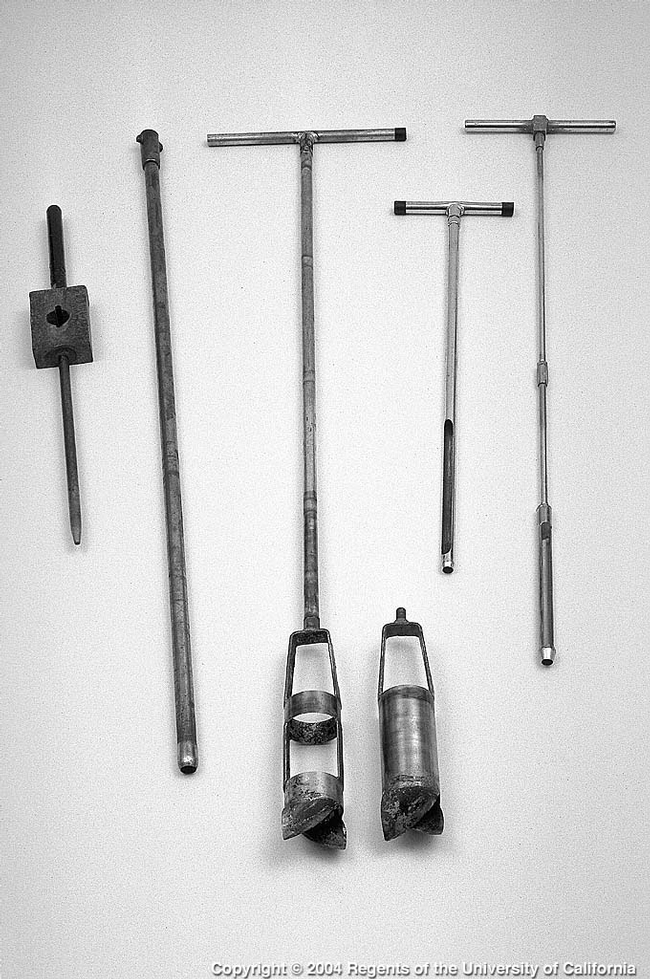Leaf analysis is the preferred method of guiding a fertilizer program for fruit tree crops. Soil testing is less important, since the tree has the capacity to store nutrients in its various parts – roots, trunk, stems and leaves. However, soil testing is a component of a plant nutrient management program and has been standard practice for growers to aid in adjusting fertilizer applications. Soil testing is performed not only to improve plant growth, but also to reduce over-application of fertilizers that may lead to nutrient toxicities, excessive leaching and consequent economic losses.
For maximum accuracy and benefit, soil testing must be conducted using reliable methods on correctly-sampled soils (if the user is not trained in obtaining representative soil samples, test results even from the same soil can vary greatly). Test results must also be properly interpreted for a specific crop. Interpretative guidelines are readily obtainable for many agronomic and horticultural crops, as well as landscape trees. Cost for laboratory analysis for pH, NO3-N, P2O5 (Olsen), and extractable K2O are typically under $20 per analysis, but frequently results take from 1-4 weeks to get back to the grower.
By contrast, many retail garden centers offer commercial test kits, ranging in cost from $10 to $50 for multiple tests, so that the cost per test can be relatively low. These commercial kits are also advantageous because results can be obtained within one to two days. Commercial kits typically use a colorimetric method for indicating macronutrient and pH levels. Soil is measured into a sample container, extractant is added, and after a specified time for the reaction, the user compares the color obtained to a color card corresponding to categorical nutrient and pH levels.
We have always wondered how well these kits performed, so we purchased five commercially-available test kits and compared their results to standard laboratory analysis of NO3-N, P2O5 (Olsen), extractable K2O and pH from the same soil type with three distinct cropping histories (Soils 1, 2, and 3). The objectives were to identify differences in accuracy, if any, among test kits and to suggest a kit that most closely corresponds to analytical lab results.
Four of the kits, “La Motte Soil Test Kit” (La Motte Co., Chesteron, MD); “Rapitest®” (Luster Leaf Products, Woodstock, IL); “Quick Soiltest” (Hanna,Woonsocket, RI); and “NittyGritty” (La Motte Co. Chesteron, MD) measured nitrate-N, P2O5, K2O and pH. “Soil Kit” (La Motte Co., Chesteron, MD) measured only nitrate-N, P2O5 and K2O. The kit results for macronutrients were categorical (high, medium, and low); pH results were numeric, rounding to half pH units for the Rapitest® and one pH unit for the other three kits. The manufacturers’ instructions for each kit were followed for soil testing.
Results show that pH measures from LaMotte Soil Test Kit and Rapitest consistently matched lab results. Soils 1 and 3 proved to be in the pH 6.5 range, but the pH of Soil 2 was 7.8, technically beyond the capacity of Rapitest (pH 4.5-7.5). NittyGritty did not match lab results at all. Quick SoiltTest generally indicated lower pH values than the analytical lab. Results from LaMotte Soil Test Kit, Rapitest, and Quick Soiltest consistently matched the analytical lab results for nitrate-N and P2O5, while Soil Kit and NittyGritty did not. Soil Kit and NittyGritty analyzed K2O content with greater accuracy than for the other nutrients; the commercial tests in total corresponded with the analytical lab 82% of the time for this test. For Soil 3; all the commercial test results matched the analytical lab results 100%.
Precautionary measures for these commercial kits may increase their accuracy. For Soil Kit and Nitty Gritty, the extracting powders that came with the kits dissolved poorly; these kits generally yielded inaccurate results, but pulverizing the tablets or powders may increase extraction potential. Interpretation of color development should be made only within the time specified by the kit instructions because color intensity could vary within minutes. Also, interpretation can occasionally vary depending on the user. In this study, the observers independently interpreted the same result for 91% of the tests; this would probably be an acceptable proportion for a home gardener or farmer individually conducting tests, but occasional independent interpretation by another source may change the result.
La Motte Soil Test Kit results corresponded to those from the analytical lab for pH and all nutrients (86% of the tests matched). This kit is suitable for growers because it proved to be very accurate even over a range of pH values and is housed in a hard-sided, padded container. Rapitest yielded accurate results 92% of the time for all nutrients and pH less than 7.5, and was comparatively easy to use and interpret. Quick Soiltest matched the analytical lab results only 64% of the time because pH and K2O values were inaccurate. Interpretation of values from this kit may have resulted in application of potassium in excess of the needs of Soils 1 and 2.
An important limitation of all commercial test kits is the approximate or categorical value of nutrient content (i.e., low, medium, high). Analytical labs must be used when precise values are required. Nevertheless, commercially-available kits such as Rapitest and La Motte Soil Test Kit have shown to provide accurate, fast, and economical results and can help growers improve nutrient management.
Attached Images:
